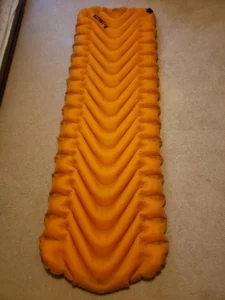Introduction
There are so many people that say quilts are better than sleeping bags, but is that really true?
In this article, we’ll look at the real pros and cons of both and share some simple tips and tricks to fix common problems. That way, you can enjoy the comfort, warmth, and lightweight benefits of each. By the end, you’ll know which one is right for you—and I’ll also share when I personally love using a quilt and when I prefer a sleeping bag!
Sleeping Bag & Quilt : What’s the Difference ?
Let’s talk about the differences bewteen a sleeping bag and camping quilt,
Sleeping bag in most situations have a hood, some of them zip halfway down and others zip all the way down, some of them are really roomy and others are very constricting. So, essentially a sleeping bag has a complete 100% insulation all the way around you and you can cinch it up to your nose or your mouth.
Whereas, a quilt is essentially a minimalist sleeping bag. It’s like the least amount of a sleeping bag they can make that will still be useful in camping to hopefully keep you warm and cozy all night long just like a sleeping bag. So, quilts don’t zip all the way up but they might zip up down by your foot into a foot box. Also, quilts don’t have a hood. So, you can’t put the hood up on you overnight.
Pro tip :
if you want to use the sleeping quilt like the sleeping bag putting the hood up, you can wear your jacket overnight as long as it has got a hood on it, or you could just wear a hat if you wanted.
| Feature | Sleeping Bag | Quilt |
| Hood | Yes, keeps your head warm | No hood—you’ll need a hat or hooded jacket |
| Zippers | Some zip halfway, others fully | Usually no zippers, except a small footbox zipper |
| Fit | Some are roomy, others tight | More open and flexible. |
| Insulation | Fully wraps around your body | Open on the bottom, so you rely on your sleeping pad for warmth. |
| Heat Control | Can be cinched up to trap heat. | Less coverage, but allows more airflow. |
| Weight | Heavier due to full coverage. | Lighter and more packable |
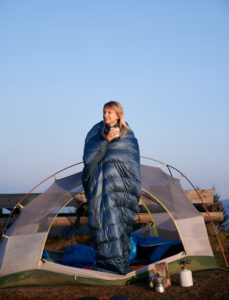
Pros & Cons of Quilts
✅ Pros of Quilts:
- Quilts are often more comfortable than sleeping bags because they let you move freely while you sleep. Since quilts stay in place and are secured to your sleeping pad with pad straps, you can easily toss and turn without shifting the entire quilt. In contrast, when using a sleeping bag, you have to rotate the whole bag with you, which can feel restrictive. A quilt feels more like sleeping under a cozy blanket at home, which is why many people find them more comfortable.
- Quilts are typically extremely lightweight when compared to a sleeping bag because there’s a lot less materials since it doesn’t have a zipper nor a hood. So, they are a lot more packable than a sleeping bag.
- quilts are really nice to be able to get in and out of without the zipper there because that way you can just quickly go to the bathroom if you have to in the middle of the night.
❌ Cons of Quilts & How to Fix Them:
❄ Problem #1: Quilts Can Be Cold
Quilts can be quite cold and there are a couple of different reasons why this may happen :
- One big reason quilts can feel cold is because they are open on the bottom, so you sleep right on your sleeping pad. If your pad isn’t warm enough, you’ll really feel the cold! But this can also be a problem with sleeping bags.
- When you lie in a sleeping bag, the insulation under you gets squished, making it less effective. If you roll from your back to your side, that flattened insulation gets exposed to the cold air, creating cold spots until it fluffs back up. Many people don’t notice this, but it can be a big problem in freezing temperatures like -20°C or even -40°C.
- A quilt, however, stays in place with pad straps, so you don’t have to worry about shifting insulation. But quilts still get cold if you don’t have the right sleeping pad. That’s why choosing a good pad is just as important as picking the right sleeping bag or quilt.
Solution:
- If you’re camping in mild weather, like spring or fall, where it’s not too hot or too cold, a sleeping pad with an R-value of around 4 is a great choice. It provides enough insulation to keep you warm and comfortable in most three-season conditions like the KLYMIT Insulated Static V Lite Inflatable Sleeping Pad
- For hot summer nights, a pad with a lower R-value, like the Sleeping Pad for Camping, is perfect since you don’t need as much insulation.

- But if you’re camping in freezing winter temperatures, you’ll need a well-insulated pad with an R-value of at least 6 or 7, like the Hikenture Sleeping Pad R-Value 6.2 Insulated Camping Mattress for Cold Weather , to stay warm and cozy all night!
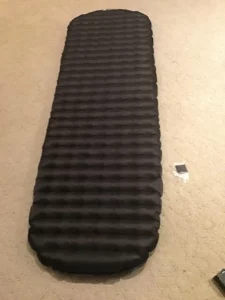
Problem #2: Drafts (Cold Air Sneaking In)
the second way that people get cold when using a quilt is drafts and that basically means that cold air is somehow sneaking in underneath the quilt and cooling you off. The first place where drafts can happen is around your neck and shoulders. So, if it gets wide open up as you kind of shift positions or move, cold air can sneak in around your neck and shoulders and cool you off, but quilt manufacturers have developed a couple ways in order to address this and it’s important to take advantage of those if you want to stay warm when using a quilt.
Solution:
A draft collar like the one in Ultralight Sleeping Bag Top Quilt is a great solution for stopping cold air from sneaking into your quilt. It adds extra insulation around your neck and shoulders, sealing in warmth and preventing drafts. If you’re worried about staying warm in a quilt, choosing one with a draft collar like the Ultralight Sleeping Bag Top Quilt can make a big difference!
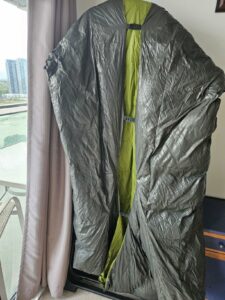
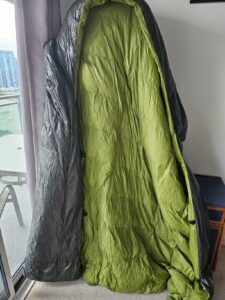
Problem #3:
Drafts are also most likely to happen along the sides of the quilt where the quilt connects to the sleeping pad with pad straps. You may connect the pad straps to the quilt but there are two reasons why the way you set them up is going to lead to draft. The first mistake that you may make with this setup is that you settle the pad straps too close together.
Solution :
What you want to do is have them as far apart as possible so that the edge of the quilt is nice and tight even just making that change you’ll be able to see that there’s much less kind of distance that the quilt can rise and there’s a lot less exposure for drafts.
Problem #4:
The second mistake that you may make is that the connection point for the pad straps are on top of the sleeping pad and that’s an easy mistake to make I think a lot of people probably just throw the pad straps onto the sleeping pad, attach the quilt and then assume that they’re good to go, but people might have missed that with the clips on the pad straps, they can move along the pad straps.
Solution:
- The best way to stay warm with a quilt is to clip the pad straps underneath your sleeping pad, right where it touches the ground. This helps the quilt wrap around the pad just a little bit—enough to keep heat in without squishing the insulation.
- When you toss and turn, the quilt stays in place, giving you more room to move without letting in cold air. You can test it by pulling on the quilt—if you’ve set it up right, there shouldn’t be any drafts along the edges.
- If you’re worried about feeling cold with a quilt, try my tips for securing the head end and using the pad straps correctly. Trust me, I’ve used quilts in temperatures as low as -30°C and stayed toasty warm!
| ✅ Pros of Quilts | ❌ Cons of Quilts & How to Fix Them |
|---|---|
| More Comfortable – You can toss and turn easily. The quilt stays put, unlike a sleeping bag. | Problem #1: Quilts Can Be Cold Why? Quilts are open on the bottom, so if your sleeping pad is cold, you will feel it. |
| Lightweight & Packable – Uses less material, making it easier to carry. | Solution: Choose a sleeping pad with the right R-value (warmth rating). |
| Easy to Get In & Out – No zippers make nighttime bathroom trips quicker. | – For 3-season camping: Use an R-value around 4. – For summer camping: Use a lower R-value.around 2. – For winter camping: Use an R-value around 6 or 7. |
How to choose the best sleeping system using quilt?
When I first started backpacking, I thought being uncomfortable at night was just part of the experience. But after trying lots of different sleeping pads and pillows, I realized it doesn’t have to be that way!
You can sleep comfortably in the outdoors—you just need the right gear. A good sleeping pad, a cozy pillow, and the right quilt can make a huge difference, even if it means carrying a little extra weight.
For the best sleeping system using quilts, you need a great pad, amazing pillow and the best sleeping camping quilt.
1.How to find the great pad:
- Look for one with the right R-value (warmth rating) for the season.
- Choose a pad that balances comfort and weight—thicker pads offer more comfort but weigh more.
- Consider size and shape—mummy-shaped pads are lighter, while rectangular ones offer more space.
- Opt for a quiet, non-slippery material to prevent sliding at night.
The best sleeping pad is Sleeping Pad for Camping since it is suitable for the 3 seasons, it is thick so it provides comfort and at the same time it is inflatable so it is lightweight and easy for backpacking. the Sleeping Pad for Camping is a rectangular one which offer a lot of room for you. Also, it is made of quiet, non slippery material
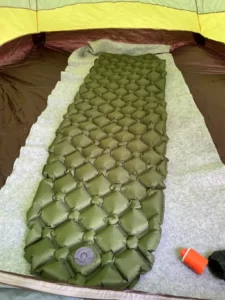
2.How to find the most comfortable pillow:
- Choose an inflatable pillow for ultralight backpacking.
- Consider a pillow with a soft and removable washable cover for easy cleaning.
- Choose a pillow with detachable elastic strap on the pack of it which keeps it in place on the sleeping pad.
The best camping pillow is the Hikenture Camping Pillow since it is inflatable, has a soft and removable washable cove, and has detachable elastic strap.
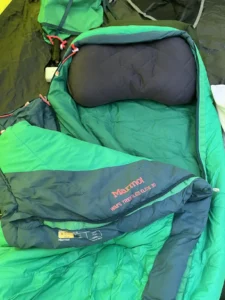
3.How to find the best camping quilt:
- Pick a quilt with the right temperature rating for the season of your trip.
- Make sure it has an effective insulation
- Make sure it has pad attachment straps to prevent drafts.
- Look for features like a cinchable footbox and a draft collar for extra warmth.
A draft collar is …..
The Ultralight Sleeping Bag Top Quilt is a great choice for all seasons because it keeps you warm and comfortable, especially in cold weather. It has a well-insulated footbox to keep your feet cozy, pad attachment straps to hold it in place and stop cold air from sneaking in, and a draft collar to block chilly air from getting inside. You can even wrap it around both your feet and the sleeping pad for extra warmth. With its secure straps and cozy design, this quilt makes sleeping outdoors super warm and comfortable.
I actually understand why people are hesitant to use sleeping quilts. I think a lot of it has to do with just unfamiliarity and once you get used to using it and figuring out the nuances in order how to use it properly then it can be awesome and a great way to save some weight and add some comfort for your sleep system.
Pros & Cons of Sleeping bags
✅ Pros of sleeping bag:
- Better Warmth & Full Coverage
A sleeping bag wraps all the way around your body, keeping you fully insulated from head to toe. Since it zips up completely, it traps heat more effectively than a quilt, making it a great choice for cold weather camping. - No Drafts or Cold Spots
Because sleeping bags have a built-in hood and a full-length zipper, they prevent cold air from sneaking in. This means you don’t have to worry about gaps or drafts, which can be a problem with quilts, especially if you move a lot in your sleep. - Easier to Use for Beginners
Sleeping bags are simple—just zip yourself in, and you’re good to go! There’s no need to worry about pad straps, draft management, or layering as much. This makes them a great option for new campers or those who want a hassle-free sleep system.
❌ Cons of Sleeping Bags & How to Fix Them:
Problem #1: Feeling Trapped
sleeping bags may be very claustrophobic.
Solution:
Choose a sleeping bag that gives you enough space to move around but not so much that it traps cold air. You want to stay warm all night while still being able to roll over easily. Some sleeping bags even have straps to keep them in place on your sleeping pad, just like the MalloMe Sleeping Bags.
Problem #2: “Sleeping Bags Don’t Keep You Warm Underneath” (Myth!)
Another myth that people say about sleeping bags all the time is that when you’re laying in your sleeping bag and you’re laying on the insulation underneath you, it’s not going to help provide any warmth.
Solution :
Sleeping Bags Keep You Warmer All Around
Some people think that a sleeping bag doesn’t keep you warm underneath because you’re laying on it. But that’s not true! Even though the insulation under you gets squished, there’s still some material providing warmth. A sleeping bag wraps around your whole body, helping to trap heat and work together with your sleeping pad to keep you cozy all night.
Quilts Only Cover the Top
A quilt is like a blanket that lays on top of you, with your sleeping pad underneath. Unlike a sleeping bag, a quilt doesn’t have any insulation under you. That means your warmth depends completely on your sleeping pad.
The Right Sleeping Pad Matters!
No matter which one you choose—a quilt or a sleeping bag—you need the right sleeping pad. If your pad isn’t warm enough for the weather, you’ll feel cold no matter what! Always check the R-value (warmth rating) of your sleeping pad to make sure it matches the conditions you’ll be camping in.
The sleeping pad that I really recommande is the Sleeping Pad for Camping since it is suitable for the 3 seasons, it is thick so it provides comfort and at the same time it is inflatable so it is lightweight and easy for backpacking. the Sleeping Pad for Camping sleeping pad is a rectangular one which offer a lot of room for you. Also, it is made of quiet, non slippery material
The best sleeping bag : How to choose it
The sleeping bag from MalloMe Sleeping Bags for Adults is really because it has enough room but not too much that it traps cold, it comes with securing straps that can be tied to the sleeping pad, and it also has drawstrings in the headrest to bring the bag a little closer to your head for extra warmth.
Sleeping Bag vs. Quilt: Which One Should You Pick?
When to Use a Quilt vs. a Sleeping Bag
I love both quilts and sleeping bags, but I use them in different situations.
- Quilt: I use a quilt when it’s warm outside—during summer, late spring, and early fall. Quilts are great for warmer temperatures because they let me move freely and stay cool.
- Sleeping Bag: I use a sleeping bag when it’s really cold or when I’m hiking in the mountains. If I’m at different elevations, like going from 2,000 feet to 8,000 feet, I want full coverage to trap heat and stop drafts.
Even though pad straps help keep quilts in place, I roll around a lot in my sleep. That’s why I prefer quilts for warm weather and sleeping bags for cold climates. Both work great—you just have to pick the right one for the temperature.

